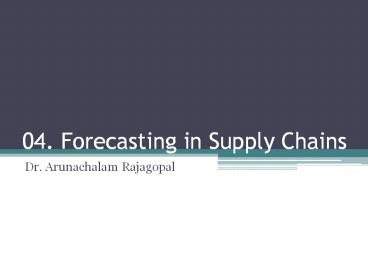Forecasting in Supply Chains: Lecture 04 - PowerPoint PPT Presentation
Title:
Forecasting in Supply Chains: Lecture 04
Description:
Forecasting in supply chains has been explained briefly in this presentation. The forecasting techniques covered are: simple moving average, exponential moving average, regression analysis, and seasonal forecasting model. – PowerPoint PPT presentation
Number of Views:143
Title: Forecasting in Supply Chains: Lecture 04
1
04. Forecasting in Supply Chains
- Dr. Arunachalam Rajagopal
2
Forecasting
- Forecasting is one of the main functions of the
supply chain management. - Customer demand is the basis for all the supply
chain activities and the purpose for which it
exists. - An accurate estimation of customer demand will
enable better planning and smooth flow of
materials through the supply chain.
3
Bullwhip Effect
- The customer demand forecast by the members of
the supply chain is influenced by the
availability of information. - The information on the actual customer demand
gets distorted at every stage of the supply chain
when it flows upstream to the supplier and to the
suppliers supplier. - This leads to higher inventory buildup at the
upstream end of the supply chain and this
phenomenon is called Bullwhip Effect.
4
Position of forecasting in decisions
5
Forecasting steps involved
6
Forecast - Range
- The forecasts can be classified into the
following categories based on the time horizon
considered while the forecast is made - short-range (less than 1 year)
- medium-range (1 to 3 years)
- long-range (more than 3 years generally long
range forecast into future which is beyond 5
years).
7
Type of forecasts
- Product demand forecast
- Technology forecast
- Weather forecast
8
Forecasting Methods
9
Qualitative Forecasting Techniques
- Judgmental forecasting
- Personal insight
- Panel Consensus
- Market survey
- Historical analogy
- Delphi method
10
Quantitative Forecasting Techniques
- Projective Techniques (Time series analysis)
- constant series
- series with trend
- seasonal series
11
(No Transcript)
12
Projective Forecasting
- Projective forecasting is intrinsic, as it
examines historical values for demand and uses
these to forecast the future. - Projective forecasting ignores any external
influences and only looks at past values of
demand to suggest future values. - Simple averages
- Moving averages
- Exponential smoothing
13
Simple Averages
14
Moving Averages
15
Exponential Smoothing
16
Exponential Smoothing Example
17
Exponential Vs. Moving Average
18
Causal Forecasting
- This technique relates one or more intrinsic or
extrinsic variables to the demand for the
product. - For example, the demand for, say, Ford Ikon
passenger car may be related to - intrinsic variables such as product quality,
service, image of the product etc. - extrinsic variables such as disposal income, GDP,
or government policy on excise duty.
19
Causal Forecasting
- Causal forecasting techniques are more accurate
than time series analysis. - Causal forecasting methods are Regression,
econometric models, simulation. - Causal forecasting looks for a cause or
relationship that can be used to forecast.
20
Causal Forecasting - Regression
21
Causal Forecasting - Regression
22
Causal Forecasting - Regression
23
Causal Forecasting - Regression
24
Causal Forecasting - Regression
25
(No Transcript)
26
Contd.,
27
Causal Forecasting - Regression
- a value of r1 indicates that the two variables
have a perfect linear relationship and the value
of one variable increases as the other variable
increases. - a low positive value indicates that there is a
weak linear relationship - When r0, there is no correlation at all between
the two variables and they are randomly
dispersed. - a low negative value of r, indicates that there
is a weak relationship and that the value of one
variable decreases as the other increases. - r -1 indicates that there is a strong negative
relationship between the variables.
28
Model for Seasonality and Trend
- Underlying value (u) is the basic demand that
must be adjusted for seasonality and trend. - Trend (t) is the long term direction of a time
series. It is typically a steady upward or
downward movement. - Seasonal index (S) is the regular variation
around the trend. Typically this shows the
variation in demand over a year. - Noise (N) is the random noise whose effects can
not be explained. - Then, Demand D (ut) SN
29
Model for Seasonality and Trend
- For calculations, it is easier to combine the
underlying value and trend into a single
variable, T, the underlying trend. Residual or
error is shown as e. The forecast model is as
given below - F T S e
30
Model for Seasonality and Trend - Example
31
Model for Seasonality and Trend Example
(contd.,)
32
Model for Seasonality and Trend
Period Actual Demand Deseasonalised Trend value Seasonal Index
1 191 141.46 1.35
2 220 159.51 1.38
3 42 177.56 0.24
4 98 195.61 0.50
5 289 213.66 1.35
6 312 231.71 1.35
7 171 249.76 0.68
8 205 267.81 0.77
9 392 285.86 1.37
10 418 303.91 1.38
11 263 321.96 0.82
12 288 340.01 0.85
33
Model for seasonality and trend
34
Model for seasonal data with an underlying trend
35
(No Transcript)
36
Conclusion
- No single method will be able to give the best
forecast demand for the product (or)
organization. - The individual (or) panel responsible for
forecast may arrive at an initial forecast. - Then, the forecast made with selected model gets
refined by taking into consideration the
subjective opinions given by experts and also by
possibly use of brainstorming (or) discussions
with all those concerned with the forecast.
37
Thank You































